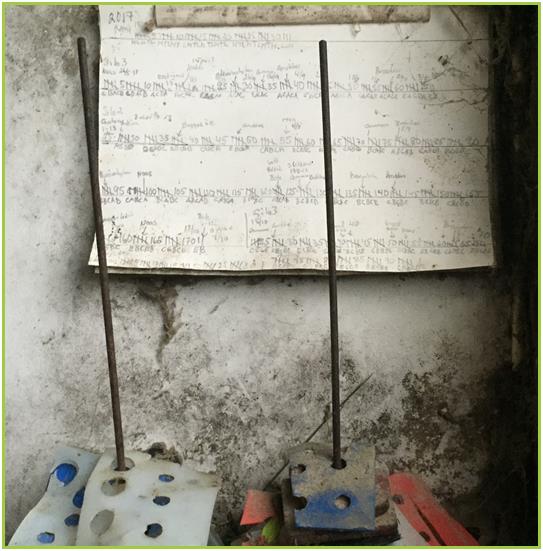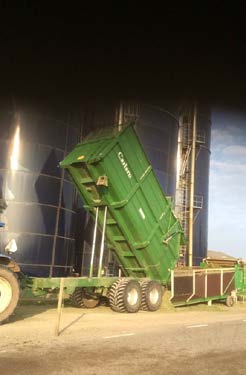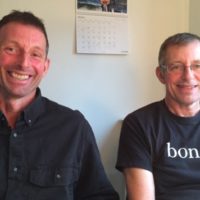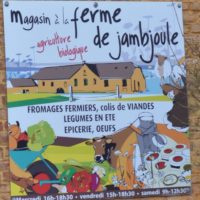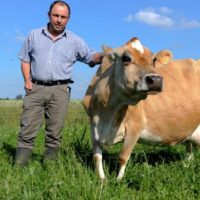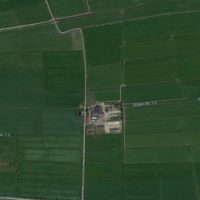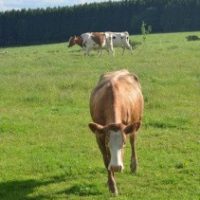Monitoring the amount and quality of silage in tower silos
Farm: “Valinge”
Location: Halland, Sweden
Case study
 Monitoring the amount and quality of silage in tower silos (.pdf)
Monitoring the amount and quality of silage in tower silos (.pdf)
Description
Background
Valinge Farm is run by three brothers and comprises a number of smaller farms with dairy, sheep and piglet units. The original farm with the dairy unit is located at Valinge, near Varberg in south-west Sweden. It has a herd of 105 cows, of both Holstein and Swedish Red breeds. The other farms have a piglet production unit with 140 sows, a sheep herd of 50 ewes and replacement heifers. In total, the farm has 250 ha of arable land and 15 ha of permanent pasture, which is grazed by the sheep and heifers. For years, the brothers have been involved in monitoring and improving their production. A deep interest in good forage is a strong driving force on the farm. The brothers derive great benefit from analysis of their forage batches, which allows them to optimise rations and to check that there is enough feed. Repeated forage analyses provide a good basis for formulating diets. The farm uses its own grass seed mix. The brothers were named Swedish Grass-land Farmer of the Year in 2013. Year after year, they achieve uniformly high milk production.
Detailed description
Most of the farm’s maize and silage is stored in tower silos. When the material is loaded into the silo, the number of loads is recorded and a numbered plastic plaque is placed after every five loads. These plaques turn up later in the feed. A different colour is used for each of the farm’s three silos and the plaques have up to three large holes, each of which indicates 50, and small holes, each of which indicates five. This system provides an indication of how fast the forage is being used. This is difficult to determine otherwise, since there is much more feed in the densely packed lower layers in the silo. It is important to know what forage is available and whether there will be enough. At harvest, a grass sample is taken for every field (around 10 ha) and sent off for analysis. There are usually six samples analysed per cut of forage. Recording the field from which the load originates makes it possible to monitor exactly which field the silage comes from.
The harvesting strategy aims at grass forage with 11.5–12 MJ energy, 160 g crude protein and 470–480 g NDF per kg dry matter. Three important conditions allow this aim to be achieved:
- The first cut must be taken in time. If it is immature, with lower NDF, more maize is added to the diet.
- The second cut must be taken 4 weeks after the first. The third cut is taken after an additional 4–4.5 weeks and the fourth cut after a further 6–7 weeks.
- The grass seed mixture used is well suited to conditions on the farm.
Results
Interest in making maximum use of the forage grown on the farm is key to the success of the system. When the results of the forage analysis are available, the farmer formulates a diet for the dairy cows based on the actual batch being taken from the tower silo. He then monitors the results when the cows start eating the silage, in terms of milk yield, milk fat and protein content and urea in the bulk tank. If necessary, he adjusts the diet. The cows are fed a daily feed mix that is intended to enable them to produce 35 kg of milk. Of this mix, 85% is grown on-farm. The cows also receive a ration of complementary concentrate in feed troughs, on which they are intended to yield up to 50 kg of milk. If the milk yield is higher, they eat more of the forage mix. The brothers who run Valinge Farm have found that this system works best for their cows and they do not want to feed more concentrate. At present, the cows produce 12800 kg milk per year. In general, the fresh forage analysis is accurate, but occasionally a complementary analysis is made on the silage. However, this is more of a retrospective check, as the silage is usually eaten before the results arrive.
‘A grass seed mixture is never set in stone’, according to the brothers on Valinge Farm. They test different species to see whether they fit into the system. The leys lie for three years. When tall fescue is present in the sward, there is more variation between batches and quality checks are even more important. When tall fescues were first tested on the farm, the variety Hykor was used and it was found that it lost its feed value if it was not harvested often enough. After a few years they changed from Hykor to Karolina, which is a few days later in development. This means that it is easier to take cuts before the feed value starts to decline. The farm is in south-west Sweden, where it is rather rainy in summer, so it is important to find a few dry days for forage harvesting. The farm has its own silage harvesting equipment, instead of relying on contractors, so it can ensure that the optimal harvesting time is exploited. Samples of grain are also sent for analysis, but it has been found that the quality does not differ as much between years in that case. Samples are usually taken from each type of cereal.
Adoption criteria
On Valinge Farm, they believe that their system of recording the loads that come from different fields can also be applied in a round bale system. In that case, the bales could be labelled or placed in order of feeding. The advantage of analysing the fresh forage is that the results are available when it is time to start feeding the silage and the diet can be formulated directly.
Future prospects
Sometimes the results of the forage analysis are not consistent with the milk yield. The first cut is often better than it appears on paper. 2018 was a very dry year, with smaller forage yields. By growing much of the feed themselves and also growing extra cereal for sale, Valinge Farm is able to cope with such fluctuations.

